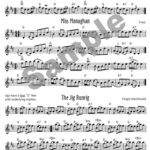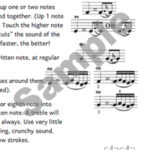 Happy St. Patrick’s Day! My recently released, curated collection of fiddle tunes is currently on sale at Amazon. You can also grab a PDF copy right away via download purchase.
Happy St. Patrick’s Day! My recently released, curated collection of fiddle tunes is currently on sale at Amazon. You can also grab a PDF copy right away via download purchase.
 I put together this Fiddle Fundamentals Folio book to answer the question: “Why play etudes when you can play fiddle tunes?” Introducing fiddle tunes into students’ (or your own) etude practice builds finger dexterity, bowing agility, and sight reading skills while also being FUN! I collected 40 toe-tapping traditional fiddle tunes and arranged them by key signature and sequential difficulty, from beginning to advanced levels. First-position-only tunes can be played slow to fast while focusing on the following technical skills:
I put together this Fiddle Fundamentals Folio book to answer the question: “Why play etudes when you can play fiddle tunes?” Introducing fiddle tunes into students’ (or your own) etude practice builds finger dexterity, bowing agility, and sight reading skills while also being FUN! I collected 40 toe-tapping traditional fiddle tunes and arranged them by key signature and sequential difficulty, from beginning to advanced levels. First-position-only tunes can be played slow to fast while focusing on the following technical skills:
Finger Dexterity: Fiddle tunes require rapid finger action on one or two strings. Ornamentations increase the speed of finger dropping-and-lifting and can train a light, tension-free touch. Students can learn preparatory double-stop technique through the focus on “quiet fingers” that stay put as long as possible. Guidance for turning tunes into finger exercises will get fingers flying faster and more accurately in no time!
Bowing Agility: Use fiddle tunes to focus on left side/right side coordination. The characteristic rapid string changes and off-beat slurs call for a relaxed, flexible technique and mindset.
 Sightreading: Fiddle tunes can be deceptively simple to play at sight. The trick is in maintaining full-speed tempos, bowings, and ornaments while always reading at least one note ahead. The 40 tunes in this book will provide lots of fresh music to play, and resources are included to find even more.
Sightreading: Fiddle tunes can be deceptively simple to play at sight. The trick is in maintaining full-speed tempos, bowings, and ornaments while always reading at least one note ahead. The 40 tunes in this book will provide lots of fresh music to play, and resources are included to find even more.
 Improvisation: Traditional techniques for adding slurs and ornaments allow the musician to play a tune differently each time. Preparatory scales and arpeggios are provided for each key, with introductory chord theory and chords for every tune, to help bridge players towards harmonic and chordal improvisation.
Improvisation: Traditional techniques for adding slurs and ornaments allow the musician to play a tune differently each time. Preparatory scales and arpeggios are provided for each key, with introductory chord theory and chords for every tune, to help bridge players towards harmonic and chordal improvisation.
Here’s the table of contents.
If you can’t wait to get your hands on some tunes to play this weekend, you can purchase a PDF copy below. It doesn’t have a fancy cover like the book you can buy on Amazon, but the inside looks exactly the same! I would love to hear your comments after you’ve used the book! Sláinte!
Download “Fiddle Fundamentals Folio” PDF for $8.50
or Purchase bound book version on Amazon

